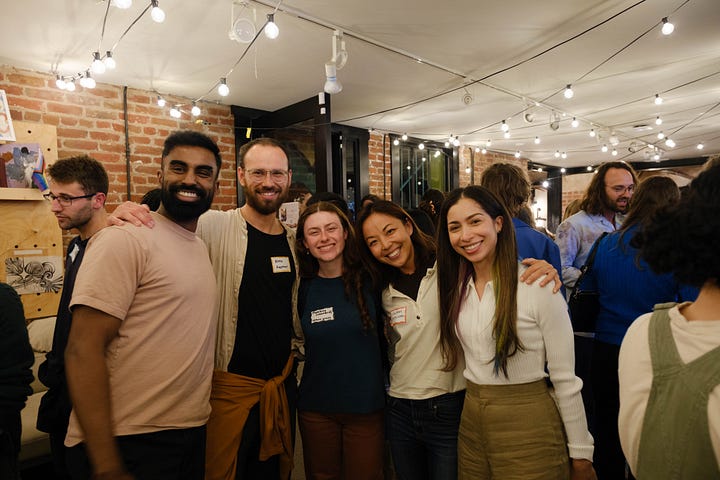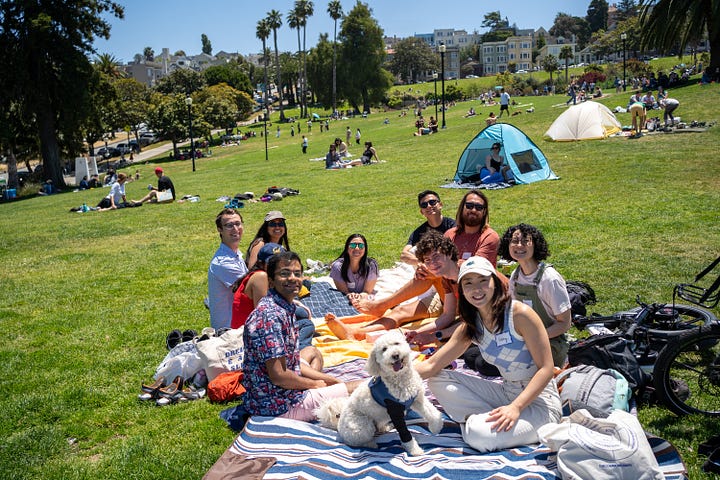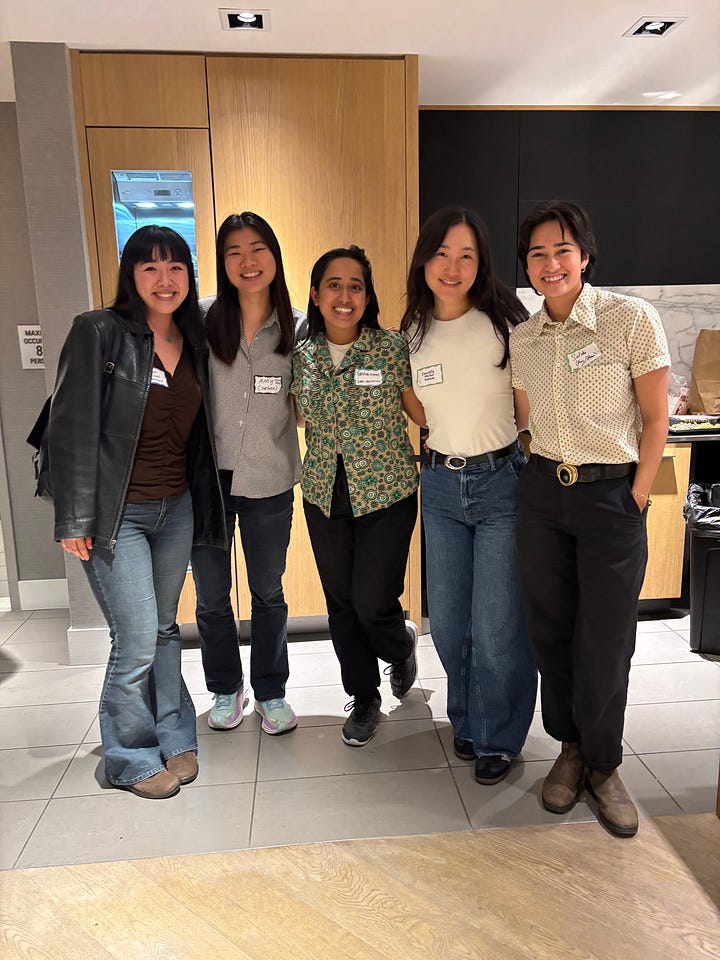Mid-year Reflections: What We’ve Learned From Building Climate Action Club
Lessons from the last six months of community building and where we’re headed next




We just passed the summer solstice and found ourselves reflecting on what we’ve learned in the past six months of building Climate Action Club, a growing community of people who care about climate, justice, and collective action.
What began with a few potlucks and discussion questions has turned into something that feels much bigger than any one event or format. Along the way, we’ve learned a lot about what people are craving, how community actually grows, and what it means to build something in alignment with our values… even when it’s slower or messier than expected.
Here are a few of the lessons we’re taking with us:
Community Is Missing — And Deeply Needed
In an increasingly remote and digital world, people are craving real, in-person connection, especially around topics as heavy and urgent as the climate crisis. We’ve heard from folks that they often don’t have friends or coworkers they can talk to about societal or environmental issues. Life is tough enough without the unrelenting news cycle. It’s become normal for us all to deal with anxiety and dissociation in isolation.
But climate action isn’t just about taking “action”. It’s about having a place to process grief, sit with uncertainty, and connect with others who care. The value of community in climate work is often downplayed, but we’ve seen firsthand how it reduces anxiety, fuels energy, and keeps people engaged over time.
Community is often seen as an extra or a nice-to-have. When in reality, it’s an essential component of climate action. It’s infrastructure. It doesn’t just build resilience, it builds momentum. Even though you aren’t actively contacting your representatives or taking on a brand new climate project, community work is climate action. Just look at how relationships fueled nearly every powerful social movement in history.
Expanding Who Belongs
We originally focused on “young professionals” largely because most climate networking events in SF were dominated by senior folks in VC, climate tech, or corporate sustainability. It felt intimidating for newer or less conventional voices to speak up.
But we’ve since realized that intergenerational dialogue is essential and that limiting age doesn’t align with our values.
We’ve opened our events to people at all stages of life. And we’ve been energized by what happens when we bring together lived experience and new energy. It’s made our conversations richer and our vision wider.
Pacing With Intention
There’s been a real tension between wanting to move fast as a small leadership team and taking time to include the community in decisions. We’ve had to ask ourselves: Do we want to be efficient? Or do we want to build shared ownership?
We’re not trying to treat this like a startup. We’re building a movement. That means slowing down, asking better questions, and sometimes choosing depth over speed.
Knowing When to Partner
We care deeply about systems change. But we’re still learning. We had moments of wanting to build our own fellowship or curriculum. Then, we recognized part of systems thinking is knowing when not to reinvent the wheel.
That’s why we’re excited to partner with RegenIntel, whose Fellowship offers incredible tools and frameworks for systems change, along with a powerful learning community.
Their next 15-week cohort is accepting applications now. As a partner, we’re thrilled to offer 40% off tuition with the code RIPARTNER2025-CAC.
Apply by June 27th and reach out if you have questions. (I’ll be in the next cohort and would love to have you join me!)
🌍 Where We’re Headed
The past six months have reminded us that climate action is about building capacity: emotional, relational, and political. We’re still figuring things out. But we believe deeply that community is climate infrastructure, and we’re proud of what we’re building together.
We’re continuing to host lectures, dinners, hikes, and picnics, but we’re thinking about our events not as one-offs, but as ongoing touchpoints. Places to learn. To question assumptions. To strengthen relationships. And to invite more people into the work.
We’re still evolving. Still listening. Still learning. And we’re so grateful to be building this with you.
Sam
Founder and Marketing Lead, Climate Action Club
Upcoming Events
🌱 Climate Picnic
Thursday, June 26 | 5:30PM–7:30PM | Salesforce Park
Join us after work for a fun evening of discussion with new (and old) climate friends! We’ll snack, unwind, and dive into what’s really at stake with the IRA and reconciliation bill, as well as how we can support each other in this moment.
🔗 RSVP here.
📖 Community Event: Book Club - The Righteous Mind
Sunday, July 12 | 2PM | Dolores Park
Join our next book club to discuss “The Righteous Mind” by Jonathan Haidt. All are welcome - even if you haven’t finished the book yet!
🔗 RSVP via Slack! Get access to all of our community events by joining the Climate Action Club Slack channel. Sign up here.
Job Board
Creative Technologist and Frontend Engineer at New Public ($140,000-$160,000, remote)
Research Fellow at Civitech (remote contract for July-Nov 2025)
Carbon Management Specialist (CDR) at NRDC ($130,000-$150,000, DC/SF/NYC/Chicago/LA)
Front-End Engineer at Atlas Public Policy ($90,000-$110,000, DC)
Transportation Program Associate at Climate Imperative ($70,000-$80,000, remote)
Tech Lead at Develop for Good ($100,000-$130,000, SF)
Nonprofit Partnerships Manager at Develop for Good ($70,000-$80,000, SF)
Product Designer at Tapestry aka Google X ($129,000-$195,000, Mountain View)
Product Manager, Distribution Grid Software at Tapestry aka Google X ($168,000-$250,000, Mountain View)
Portfolio Analyst at Google X ($118,000-$155,000, Mountain View)
Senior Mechanical Design Engineer at Peak Energy ($150,000-$170,000, Burlingame)
Community Recs
🎧 Podcast: Saving Clean Energy Tax Credits:Inside the IRA Fight – Citizens Climate Lobby (listening before our picnic Thursday)
📰 Article: We Need to Think about Cap-And-Trade in CA – The Bakersfield Californian
📖 Open Access Book: The Psychology of Collective Climate Action – Karen Hamann, et al.




Heavily researched does not guarantee correct. Even one erroneous assumption in common renders pages of references, papers and citations useless. CAGW’s GHE contains three such assumptions.
GHE claims without it Earth becomes 33 C cooler, a 255 K, -18 C, ball of ice.
Wrong.
Naked Earth would be much like the Moon, barren, 400 K lit side, 100 K dark.
TFK_bams09 heat balance graphic uses the same 63 twice violating GAAP and calculating out of thin air a 396 BB/333 “back”/63 net GHE radiative forcing loop violating LoT 1 & 2.
Wrong.
Likewise, the ubiquitous plethora of clones.
GHE requires Earth to radiate “extra” energy as a BB.
Wrong.
A BB requires all energy leaving the system to do so by radiation. Per TFK_bams09 60% leaves by kinetic modes, i.e. conduction, convection, advection and latent rendering BB impossible.
GHE is bogus and CAGW a scam so alarmists must resort to fear mongering, lies, lawsuits, censorship and violence.